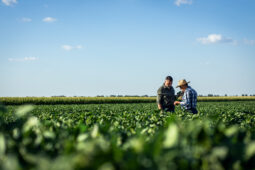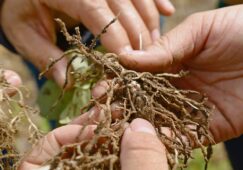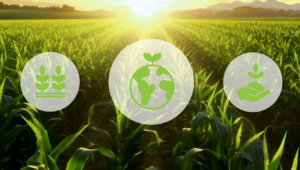Our children depend on biodiversity for the food they eat. Our growers rely on biodiversity for the success of their farms. In fact, the global food and agriculture industries rely on biodiversity – but, according to the Food & Agriculture Organization (FAO), biodiversity is in trouble. But what exactly is biodiversity, and why is it so important to us?
What Is Biodiversity?
From soil microorganisms that are invisible to the naked eye to silage corn plants, from the smallest shrimp to the beefiest cow, life on Earth is vast and varied. Biodiversity is the term for the great variety of organisms on the planet.
The FAO is emphasizing how important biodiversity is for food and agriculture – first with this report, and recently with this call for adoption of biodiversity-friendly practices in agriculture. It’s easy to underestimate how many living things contribute to our food security and economy. According to the FAO, biodiversity for food and agriculture includes:
- Domesticated plants and animals raised in crop, livestock, forest, and aquaculture systems
- Harvested forest and aquatic species
- The wild relatives of domesticated species harvested for food and other products
- Associated biodiversity, meaning the enormous breadth of organisms that live in and around food and ag production systems
With this wide definition, it’s easier to see just how many living things are involved in food production – and why it’s up to us to protect them.
Why Does Biodiversity Affect Agriculture?
The FAO points out a few key reasons why we need biodiversity to live, eat, and thrive.
- Biodiversity makes production systems more resilient to stressors like climate change, disease, and other environmental stressors.
- More resilient systems mean more stable food supplies, and more consistent income for farmers, growers, and food suppliers.
- It’s a key resource to increase food production without outstanding negative environmental impact.
- It reduces the need for disruptive, costly, or harmful external inputs (like excessive pesticides or fertilizers that overwhelm natural systems).
It’s also important to understand that we don’t yet know all the ways food production systems rely on the variety of plants and animals surrounding them. This is especially true when it comes to “associated biodiversity.” Many species have never been identified or described, including a huge number of uncategorized or poorly understood soil microorganisms. Yet, emerging research is illustrating how microorganisms, or the lack thereof, can help or harm a harvest.
All of us have an interest in preserving biodiversity, for these reasons and more. The first step is to get educated about the problem.
Decline in Diversity
“Key components of biodiversity for food and agriculture at genetic, species, and ecosystem levels are in decline,” warns the FAO. What does that actually mean? Here are some indicators the FAO used:
- 26% of livestock breeds are at risk for extinction
- In farmers’ fields, plant diversity is decreasing and threats to diversity are increasing
- Soil hosts a quarter of the world’s biodiversity, but 20-30% of the world’s land is degraded
- Ecosystems that provide essential services (supply of freshwater, protection against hazards, and the habitats of beneficial species) are declining rapidly
Wetlands, mangroves, coral reefs, and rangelands are all in decline or at risk. Many species of plants and animals are threatened. And all of this is connected to our food supply! To solve the problem, first we have to understand it.
What's Causing the Decline?
We need to know what the drivers of biodiversity loss are before we can try to fix them. Unfortunately, there are a number of factors that are interconnected. Moreover, the factors can compound, or operate at different levels, so each one has a wide range of impact.
The FAO points out that many key factors are related to “inappropriate agricultural practices.” For example, pollution, overuse or misuse of agricultural inputs, overharvesting, and change in land and water management can all harm biodiversity.
There is a bright side: if we embrace changes the FAO is recommending, we can reduce or stop biodiversity losses, and maybe even begin to rebuild biodiversity.
Transformative Changes: How Ag Can Support Biodiversity
The good news is that there are many ways we can support biodiversity. The FAO reports that use of biodiversity-friendly practices is increasing. One way to help is by simply increasing awareness of these practices, and engaging industry, government, and consumer stakeholders about the importance of biodiversity.
Incorporating and improving sustainable agriculture practices is another major way to tackle loss of biodiversity.
Some practices that promote biodiversity are:
- Crop rotation
- Intercropping
- Cover cropping
- Conservation tillage
- Organic matter management
All of these practices contribute to better soil productivity. Growing awareness of soil productivity and preservation reflects a shift towards sustainability, as soil is one of our most important resources – and an important host to an incredible amount of diversity. Improving soil productivity means more healthy crops can be grown on the same plot of land, which can reduce overharvesting and improper agricultural inputs.
How BiOWiSH Solutions Support Biodiversity
At BiOWiSH, we know that the best solutions need to be easy and cost-effective to implement. One way to encourage productive soil is to incorporate biotechnology into agricultural practices. After years of research and development, BiOWiSH has formulated proven solutions that work seamlessly into current agricultural methods.
BiOWiSH® Crop Technology adds beneficial microbes that improve soil productivity, building up the microbial community in the soil. Best of all, it is easy to use – when fertilizer suppliers add BiOWiSH® Crop Liquid to their fertilizer products, all growers need to do is apply it. Growers can get more out of their fertilizer and more out of their farmland with BiOWiSH®, because BiOWiSH® Crop Technology improves nutrient use efficiency and crop yield.
The incredible diversity of life on Earth is under threat, but we are up to the challenge of creating solutions that support biodiversity. BiOWiSH is excited to be a part of the growing movement towards more sustainable agricultural practices.
If you want to join us in our mission to create a more sustainable future, contact a BiOWiSH agronomist now.





